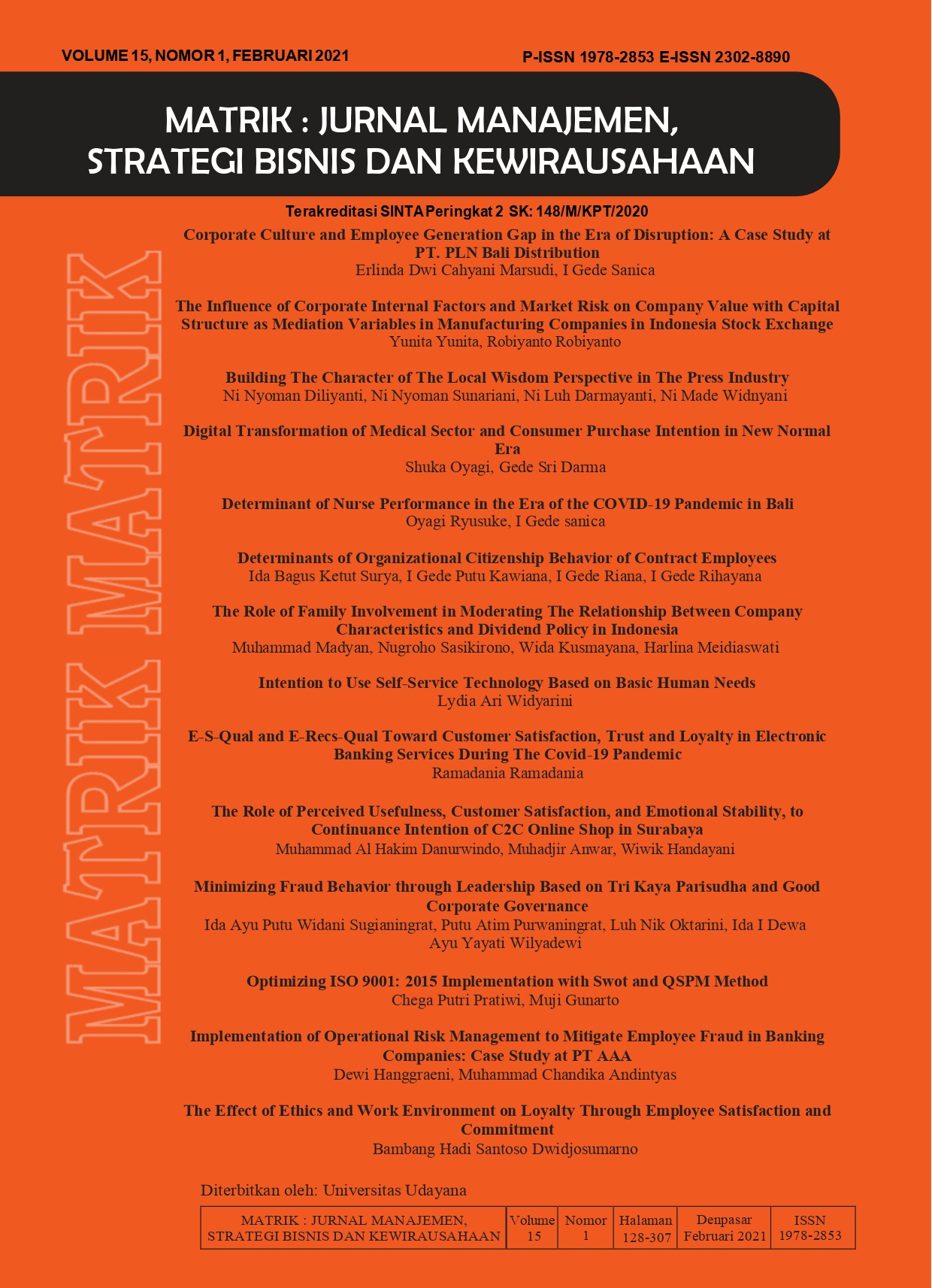The Role of Perceived Usefulness, Customer Satisfaction, and Emotional Stability, to Continuance Intention of C2c Online Shop in Surabaya
Abstract
Fenomenon of C2C online shop which is currently in high demand by customers, has effect to the increasing with the amount an level of competition between companies. The purpose of this study is to examine the factors that can influence continuance intention of C2C online shop. The population in this study is consumer of C2C online shop in Surabaya city, and the research sample being C2C online consumers who have bought at least 1 transaction in a minimum period of 1 year purchased by 100 people. The method used in this study is a quantitative method, with PLS (Partial Least Square) analysis technique. The results showed that perceived usefulness and customer satisfaction has effect to the continuance shop intention. Perceived usefulness has effect to the customer satisfaction. Emotional stability has not effect in moderating perceived usefulness into the customer satisfaction. Customer satisfaction has effect tn mediating of the perceived usefulness into the continuance shop intention . The research implications show that continuance shop intention can increase customer purchase transactions at C2C online Shop.
Keyword: Continuance shop intention, Customer satisfaction, Perceived usefulness, Emotional stability, C2C Online shop
Downloads
References
Al- Maghrabi, T., & Dennis, C. (2011). What drives consumers’ ontinuance intention to e-shopping? International Journal of Retail, 39(12), 899 - 926. doi:10.1108/09590551111183308
Amin, M., Rezaei, S., & Abloghasemi, M. (2014). User satisfaction with mobile websites: the impact of perceived usefulness (PU), perceived ease of use (PEOU) and trust. Nankai Business Review, 5(3), 258-274. doi:10.1108/NBRI-01-2014-0005
Chin, W. W. (1998). The Partial Least Square Approach for Structural Equation Modeling. Modern Methods for Business Research, 295-336.
Chin, W. W. (2010). Handbook of Partial Least Square "How to Write Up and Report PLS Analyses. New York: Springer.
Davis , F. (1989). A technology acceptance model for empirically testing new end-user information systems: theory and results. Doctoral Dissertation, Cambridge, MA: MIT Sloan School of Management.
Davis, F., Bagozzi, R., & Warshaw, P. (1989). User acceptance of computer technology: A comparison of two theoretical models. management science, 35, 983 - 1003.
Frijda. (1993). Moods, Emotion Episodes and Emo-tions. 381.
Ghozali, I. (2011). Aplikasi Analisis Multivariate dengan Program IBM SPSS 19. Semarang: Universitas Diponegoro.
Ghozali, I., & Latan, H. (2015). Partial Least Square Konsep, Teknik, dan Aplikasi menggunakan program Smart PLS 3.0 untuk penelitian empiris. Semarang: Badan penerbit Universitas Diponegoro Semarang.
Habibillah. (2018, Agustus 11). Pengaruh Kepuasan Pelanggan Sebagai Variabel Intervening pada Hubungan Kualita Pelayanan dengan Pembelian Ulang Perusahaan Jasa Pengiriman Barang di Surakarta. Surakarta, Jawa Tengah, Indonesia: Prodi Manajemen FEB Universitas Muhammadiyah Surakarta.
Hair,, J. F., Black, W. C., Babin, B. J., & Anderson, R. (2010). Multivariate data analysis (7 ed.). Upper Saddle River.
Hair, J., Ringle, C., & Sarstedt, M. (2011). PLS-SEM: Indeed A Silver Bullet. Journal of Marketing Theory and Practice, 19(2), 139-150.
Hair, J., Sarstedt, M., Ringle, C., & Meena, J. (2012). An Assessment of the Use of Partial east Square Structural Equation Modeling in Marketing Research. Journal of the Academy of Marketing Scince, 40(1), 414-433.
Handayani W. 2018. Pengaruh Store Environment, Personal Value, Working Self Concept, Dan Affect Terhadap Impulse Buying Studi pada Generasi Y yang Berbelanja di Departemen Store dalam Mall [Disertasi]. Surabaya: Universitas Airlangga (http://repository.unair.ac.id/70354/)
Hsu, J. C., Lin, T. C., Fu, T. W., & Yu, W. H. (2015). The effect of unexpected features on app users’ continuance intention. Electronic Commerce Research and Applications, 14(6), 418-430.
Hume, D. (2012). Emotions and moods. Organizational behavior, 258-297.
Koppius, O., Speelman, W., Verhoef, B., & van Heck, E. (2005). Why are customers coming back to buy their airline tickets online? Theoretical explanations and empirical evidence. Proceedings of the 7th International Conference on Electronic Commerce, 319 - 326.
Kotler, P., & Keller, K. L. (2016). Marketing Managemen (15th Edition ed.). Pearson Education,Inc.
Koufaris, M. (2002). Applying the technology acceptance model and flow theory to online consumer behavior. Information Systems Research, 13(2), 205-223.
Li, Y., & Ahlstrom, D. (2016). Emotional stability: A new construct and its implications for individual behavior in organizations. Asia Pacific Journal of Management, 33(1), 1-28.
Liaw, S.-S., & Huang, H.-M. (2013). Perceived satisfaction, perceived usefulness and interactive learning environments as predictors to self-regulation in e-learning environments. Computers & Education, 60(1), 14-24.
Lim, J. Y., Osman, A., Salahuddin, N. S., Romle, A. R., & Abdullah, S. (2016). Factors Influencing Online Shopping Behavior: The Mediating Role of Purchase Intention. Procedia Economics and Finance, 35, 401- 410. doi: 10.1016/S2212-5671(16)00050-2
Lin, C., & Lekhawipat, W. (2014). Factors affecting online Repurchase Intention. Industrial Management & Data Systems, 114(4), 597-611.
McLaughlin, C. D., Bradley , L. D., Prentice , G. D., Verner , E.-J., & Loane , S. D. (2017). Consumer to Consumer (C2C) Online Auction Transaction Intentions: an Application of the Theory of Planned Behaviour. DBS Business Review, 5-25.
Migliore, L. (2011). Relation between big five personality traits and Hofstede’s cultural dimensions: Samples from the USA and India. Cross Cultural Management: An International Journal, 18(1), 38-54.
Mohamed, N., Hussein, R., Zamzuri, N. A., & Haghshenas, H. (2014). Insights Into Individual's Online Shopping Continuance Intention. Industrial Management & Data Systems, 114(9), 1453-1476. doi:10.1108/IMDS-07-2014-0201
Monsuwe, T., Dellaert, B., & Ruyter, K. (2004). “What drives consumers to shop online? A literature review”. International Journal of Service Industry Management,, 15(1), 102 - 121.
Muktaf, Z. M. (2016). E-commerce sebagai Agen Konsumsi di Era Media Baru. International Conference on Social Politic (ICSP) .
Pradana, M. (2015). Klasifikasi Bisnis E-Commerce Di Indonesia. Modus Journal, 27(2), 163-174.
Revels, J., Tojib, D., & Tsarenko, Y. (2010). Understanding consumer intention to use mobile services. Australasian Marketing Journal (AMJ), 18(2), 74-80.
Sandhusen, Richard L. (2008). Marketing. New York: Barron's Educational Series. doi:ISBN 0-7641-3932-0, 2008
Shipps, B., & Phillips, B. (2013). Social Networks, Interactivity and Satisfaction: Assessing Socio-Technical Behavioral Factors as an Extension to Technology Acceptance. Journal of Theoretical and Applied Electronic Commerce Research, 8(1), 35-52.
Siyamtinah, & Hendar. (2015). Meningkatkan Pembelian Ulang Melalui Kepercayaan dan Kepuasan Pada Pembelanjaan Online. CBAM (Conference in Business, Accounting, and Management Fakultas Ekonomi UNISSULA (pp. 435-448). Semarang: Unissula Semarang.
Suciana, S. K. (2017, Desember). Pengaruh E-Commerce Knowledge, Risiko, dan Teknologi terhadap Kepercayaan dan Niat Beli Online. "DAYA SAING" Jurnal Ekonomi Manajemen Sumber Daya, 19(2), 86-92.
Sugiyono, P. D. (2016). Metode Penelitian Kuantitatif, Kualitatif dan R&D. Bandung: PT Alfabeta.
Suhartini, D., & Handayani, W. (2009). Model Penerimaan Teknologi Informasi Oleh Dosen Pada Perguruan Tinggi di Surabaya. Jurnal Sistem Manajemen, 13-22.Sunitha, C., & Gnanadhas, E. (2014). Online shop-ping-An Overview. B-DIGEST, 6(1), 16-22.
Tjiptono , F. (2012). Service Management Mewujudkan Layanan prima . Yogyakarta: CV Andi Offset.
Vela, S. P., Chou, S. Y., Melcher, A., & Pearson, J. (2010). Why provide an online review? An extended theory of planned behavior and the role of Big-Five personality traits. Computers in Human Behavior, 26, 685 - 696. doi:10.1016/j.chb.2010.01.005
Wen, C., Prybutok, V. R., & Xu, C. (2011, February 18). An Integrated Model for Customer Online Repurchase Intention. Journal of Computer Information Systems, 14-23.
Wu Wu, L. Y., Chen, K. Y., Chen, P. Y., & Cheng, S. L. (2014). Perceived value, transaction cost, and repurchase-intention in online shopping: A relational exchange perspective. Journal of Business Research, 67(1), 2768-2776.
Zhao, Q., Chen, C. D., & Wang, J. L. (2016). The Effects of Psychological Ownership and TAM on Social Media Loyalty: An Integrated Model. Telematics and Informatics. doi:10.1016/j.tele.2016.02.007
 This work is licensed under a Creative Commons Attribution-ShareAlike 4.0 International License.
This work is licensed under a Creative Commons Attribution-ShareAlike 4.0 International License.

















